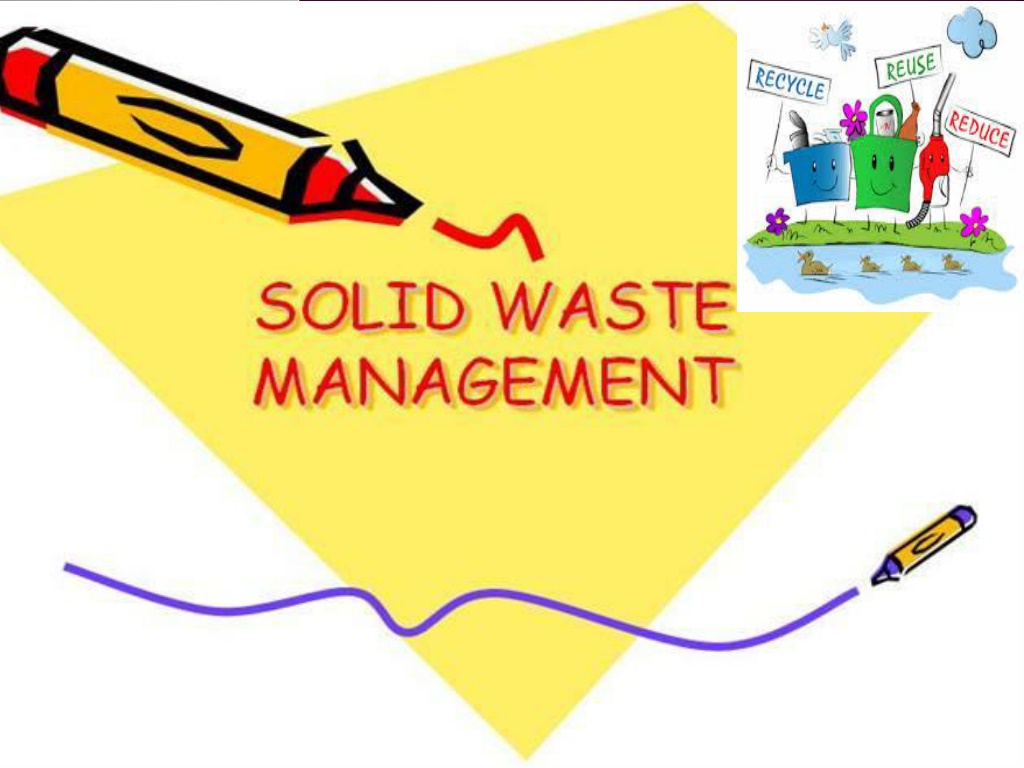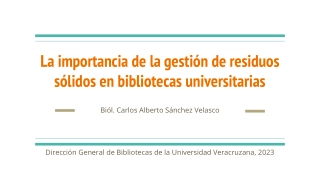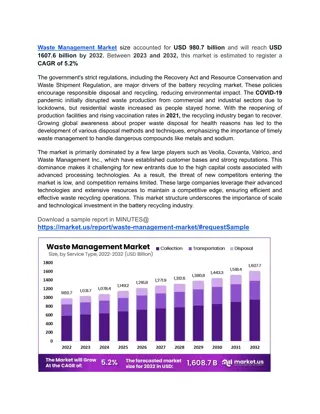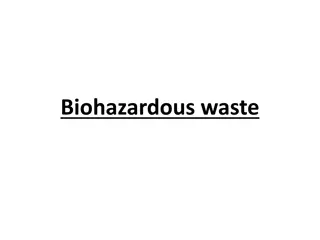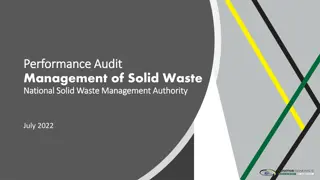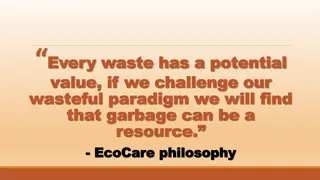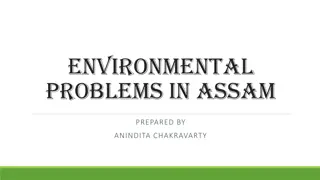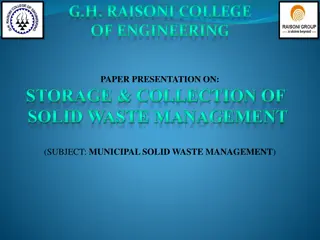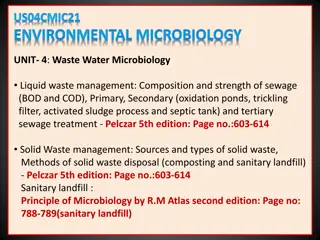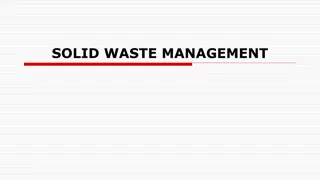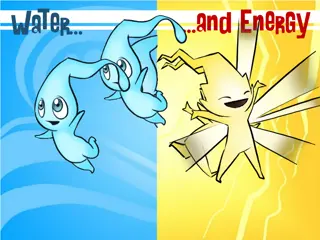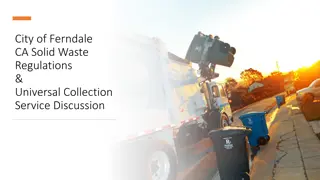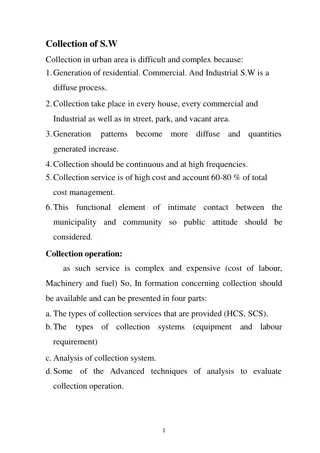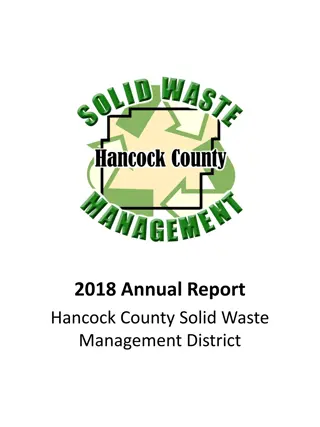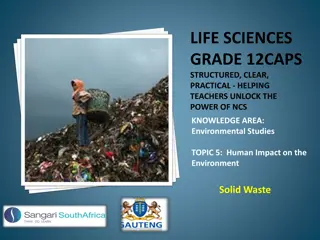Understanding Solid Waste Management and Classification
Waste management encompasses a wide range of materials and practices, from solid and liquid waste to hazardous and non-hazardous substances. Learn about different types of waste, sources of waste generation, classifications based on health and environmental impact, as well as origins and types. Explore the complexities of managing waste from households, industries, agriculture, and more for a cleaner and healthier environment.
Download Presentation

Please find below an Image/Link to download the presentation.
The content on the website is provided AS IS for your information and personal use only. It may not be sold, licensed, or shared on other websites without obtaining consent from the author. Download presentation by click this link. If you encounter any issues during the download, it is possible that the publisher has removed the file from their server.
E N D
Presentation Transcript
SOLID WASTE MANAGEMENT
WASTE It is defined as Waste (also known as rubbish, trash, refuse, garbage, junk) is any unwanted or useless materials. OR Any materials unused and rejected as worthless or unwanted and A useless or profile less activity using or expanding or consuming thoughtlessly or carefully.
TYPES OF WASTE Solid waste Liquid waste Gaseous waste Biodegradable waste Chemical waste Commercial waste/ Business waste Biomedical waste
SOLID WASTE It is defined as sludge, non-soluble materials ranging from municipal garbage to industrial wastes that contain complex & sometimes hazardous substances Solid waste also include Garbage Rubbish Demolition products Sewage treatment residue Dead animals Manure and other discarded material.
SOURCES OF WASTES Households Industry
SOURCES OF WASTES Agriculture Fisheries
CLASSIFICATION OF WASTES ACCORDING TO THEIR EFFECTS ON HUMAN HEALTH AND THE ENVIRONMENT Hazardous wastes Substances agriculturally, or economically and have any of the following properties- ignitability, corrosivity, reactivity & toxicity. unsafe to use commercially, industrially, Non-hazardous Substances agriculturally, or economically and do not have any of those properties mentioned above. These substances usually create disposal problems. safe to use commercially, industrially,
CLASSIFICATION OF WASTES ACCORDING TO THEIR ORIGIN AND TYPE Municipal Solid wastes: Solid wastes that include household garbage, rubbish, construction & demolition debris, sanitation residues, packaging materials, trade refuges etc. are managed by any municipality. Bio-medical wastes: Solid or liquid wastes including containers, intermediate or end products generated during diagnosis, treatment & research activities of medical sciences. Industrial wastes: Liquid and solid wastes that are generated by manufacturing & processing units of various industries like chemical, petroleum, coal, metal gas, sanitary & paper etc. Agricultural wastes: Wastes generated from farming activities. These substances are mostly biodegradable.
Continued. Fishery wastes: Wastes generated due to fishery activities. These are extensively found in coastal & estuarine areas. Radioactive wastes: Waste containing radioactive materials. Usually these are byproducts of nuclear processes. Sometimes industries that are not directly involved in nuclear activities, may also produce some radioactive wastes, e.g. radio-isotopes, chemical sludge etc. E-wastes: Electronic wastes generated from any modern establishments. They may be described as discarded electrical or electronic devices. Some electronic scrap components, such as CRTs, may contain contaminants such as Pb, Cd, Be or brominated flame retardants.
CAUSES OF GENERATION OF SOLID WASTES (i) Over-population: Solid waste generated per person multiplied by total population results in increased generation of solid waste every day. (ii) Urbanization: Urbanization requires various construction activities like construction of buildings, markets, shopping malls, roads, railways, airports, bridges, dams, water supply and sewage disposal systems. Each construction activity also generates solid wastes. (iii) Affluence: Consumers with high purchasing capacity discard obsoletegoods . This leads to solid waste generation. (iv) Advances in Technology: These lead to large scale production of goods for consumption based society preferring disposable items and almost every item packaged . All these result in generation of huge quantities of solid wastes. 10
EFFECTS OF SOLID WASTES The accumulation and improper handling of the solid wastes results in various health and environmental hazards. Some of these effects are described below: (i) Flies and mosquitoes breed on the choked drains and gully pits through solid wastes. These flies and mosquitoes than contaminate food and water. In turn, diseases like diarrhoea, amoebic dysentery, bacillary dysentery, malaria, dengue, etc. results. (ii) The stray animals and scavengers invade the garbage dumps of roadside. It results in harming the aesthetic beauty of the surroundings. (iii) Bad odors pollute the air as a result of decomposition of organic solid wastes. (iv) Percolation of decomposed garbage cause pollution of underground water and land. The crops and water supply gets contaminated and result in cholera, hepatitis, jaundice, gastro-intestinal diseases. (v) Rats living in solid waste dumping sites rapidly multiply in numbers and may cause plague and other diseases. 11
SOLID WASTE MANAGEMENT Waste management is the storage collection transport and handling recycling disposal and monitoring of waste materials.
STORAGE Storage: - Galvanized steel dust bin - Paper sack - Public bins
COLLECTION Collection - House-to-house collection - Collection from the public bins
WASTE HANDLING AND TRANSPORT Waste handling and separation involves activities associated with waste management until the waste is placed in storage containers for collection. Handling also encompasses the movement of loaded containers to the point of collection. waste is transferred from a smaller collection vehicle to larger transport equipment
RECYCLING Recycling refers to the collection and refuse of waste materials such as empty beverage container. The materials from which the items are made can be processed into new products. Materials for recycling may be collected separately from general waste using dedicated bins.
WASTE DISPOSAL METHOD Segregation Landfills Incineration Composting
SEGREGATION At the beginning of waste management, wastes should be categorized and segregated according to their category. This is because the method of disposal would be different for different wastes. For example, hospital wastes can be categorized and segregated on the basis of their weight, density and constituents. These are: Infectious: Materials containing pathogens in dangerous concentrations or qualities that, if exposed, can cause diseases. This includes waste from surgery and autopsies on patients with infectious diseases. Sharp disposable needles, syringes, saws, blades, broken glasses, nails or any other item that could cause a cut. Pathological: Tissues, organs, body parts, human flesh, fetuses, blood and body fluid. Pharmaceuticals: Drugs and chemicals that are returned from wards, spilled, outdated, contaminated, or are no longer required. Radioactive: Solids, liquids and gaseous waste contaminated with radioactive substances used in diagnosis and treatment of diseases. Others: Waste from the offices, kitchens, rooms, including bed linen, utensils, paper, etc. These wastes can be further disposed differently, according to their category.
LANDFILLS Landfill site is a pit that is dug in the ground. The solid waste is dumped and the pit is covered with a layer of soil to form a cell. The process is repeated every day so that many cells completely fill the landfill site. Finally, about 1 m of earth layer covering is done. Advantages: (i) Breeding of insects is prevented. (ii) Landfill sites can be developed as a park or a parking space. Disadvantages: (i) All types of wastes are dumped in land fill sites without segregation. When rainwater seeps through them, it gets contaminated and in turn pollutes the surrounding area, and ground water. 19
SANITARY LANDFILLS Sanitary landfill sites have liner systems and other safeguards to prevent ground water contamination. These sites are consistent with the economic considerations, hydrogeological requirements, climatic conditions and topography. Advantages: (i) The site is well above the ground water table, so underground water pollution is avoided. (ii) The site is easily accessible so process is low in cost. (iii) The site is atleast 1.5 km down wind from the commercial and residential areas so it is not offensive to the surrounding environment. (iv) The finished sanitary landfill can be used for the development of regions of recreation like parks, golf-courses etc. 20
SANITARY LANDFILLS Disadvantages: (i) Leachate from sanitary landfill site can contaminate the ground water. (ii) The sites cannot be used in future as a productive farm land. (iii) In a sanitary landfill, about 60% of the methane gas (odourless) is generated. When its concentration in air reaches about 5%, it is explosive and so very hazardous. (iv) Aesthetic problems may arise as a result of poorly operated landfill operations. 21
INCINERATION Process of burning municipal solid waste in a properly designed furnace under suitable temperature (670 C) and operating conditions. It reduces the solid waste by 90% in volume and 75% in weight. Advantages: (i) As the volume of the waste is reduced so to take the waste to the ultimate disposal site, less transportation cost is required. (ii) Larger wastes can be accommodated in a given land fill area because incineration reduces the land requirement to one-third.
INCINERATION Disadvantages: (i) Not applicable for radioactive wastes. (ii) High capital and operational costs. (iii) Air pollution chances if incineration is not properly done. (iv) Highly trained man-power is needed. 25
SOLID WASTE DISPOSAL The various method commonly employed for disposal of solid waste are explained below: Composting Composting refers to treatment of waste through aerobic decompositions of biodegradable organic matter. Under natural conditions dead vegetable and animal materials decompose under the influence of bacteria and fungi, as a result of this composting process, the organic matter is transformed into a stable humus like substance, which is a valuable manure for crops. (i) Classification of composting techniques based on oxygen use: (a) Aerobic composting: It requires high temperature and result in rapid decomposition of organic matter. Odours are also absent. (b) Anaerobic composting: It Decomposition of organic matter of solid waste is slow. It needs minimum attention. requires low temperatures. 26
SOLID WASTE DISPOSAL (ii) Vermicomposting It uses a special kind of earthworm and a container of food scraps. After some time, the food is replaced with worm droppings, a rich brown matter that serves as excellent natural plant food. The advantages of vermicomposting over conventional composting: Vermicomposting needs less space than normal composting. Vermicomposting is ideal for apartments in high density urban areas. Vermicomposting provides excellent natural plant food. 27
WASTE MANAGEMENT CONCEPT The 3Rs (Reduce, Reuse, Recycle) to be followed for waste management.
REDUCE Disposable goods: paper plate, paper bowl, Styrofoam cup, plastic spoon, roll of paper towels, paper napkin; Durable goods: ceramic/plastic plate, metal spoon, glass/plastic drinking cup, dish towel, cloth napkin) Recovery of one tonne paper can save 17 trees.
REUSE Instead of buying new containers from the market, use the ones that are in the house. Don t through away the soft drink can or bottle cover them with home made paper or paint on them and use them as pencil stands or small vases.
RECYCLE Use shopping bags made of cloth or jute which can be used over and over
WASTE MANAGEMENT POLICIES Environment protection act, 1986 Water (prevention & control of pollution) act,1987 Air (prevention & control of pollution) act,1981 Hazardous waste rule 1985 Bio-medical waste rule 1998 Municipal solid waste rule 2000 Waste management act 1996 Solid waste policy in India 2006
ADVANTAGES OF RECYCLING & WASTE UTILIZATION Directly or indirectly recycling & waste utilization contributes to economic development. Recycling is helpful in conservation of natural resources. Recycling can reduce/ control environmental pollution substantially. Employment opportunities also generated.
T H A N K ` YOU
